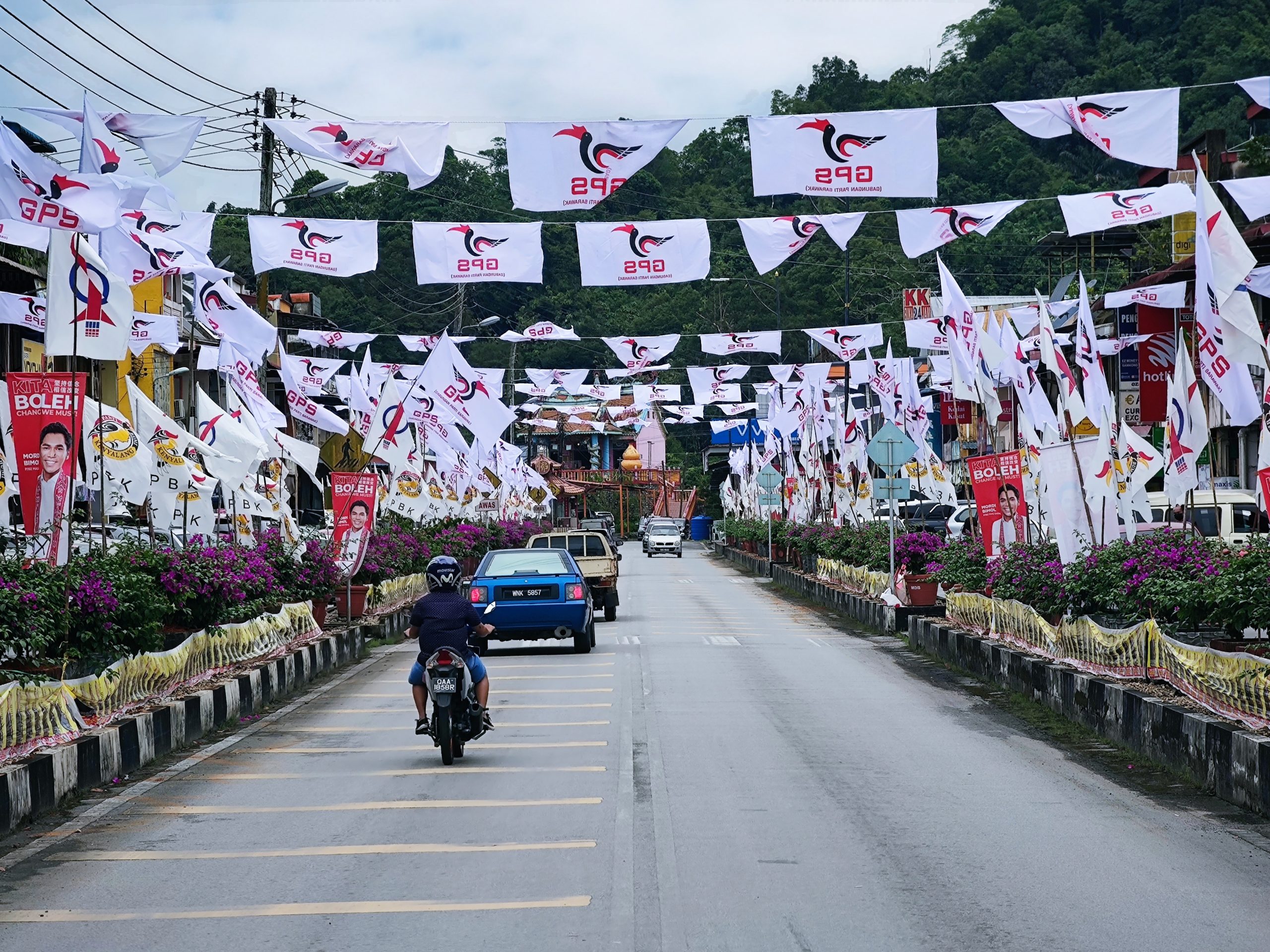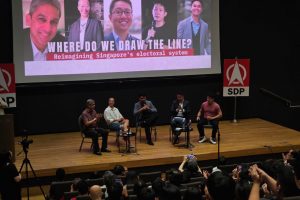All images by the author.
It is election season once again in Malaysia. This should be obvious from the rows of flags planted at every corner of the country, dangled from pole to pole, and paired with billboards and banners.
They all scream the same thing. “Vote for me, I am better than the other one”.
Malaysia’s over-the-top flag war is an unavoidable part of election culture that sees each coalition party pulling off their best roadside campaign stunts to boost visibility.
A tall pyramid of mini flags propped up by metal poles in my town of Kuching, Sarawak, may take the top prize for best-in-show. It might even elicit a chuckle or two for its absurdity. Still, this display of party colours marks an aggressive attempt to secure the turf for participating candidates.
Behind the scenes of this lavish (and practical) political peacocking are party volunteers who sometimes risk their lives installing flags by the busy streets.
Because when it comes to the flag war, the race to conquer territories and constituencies waits for no one—safety be damned.
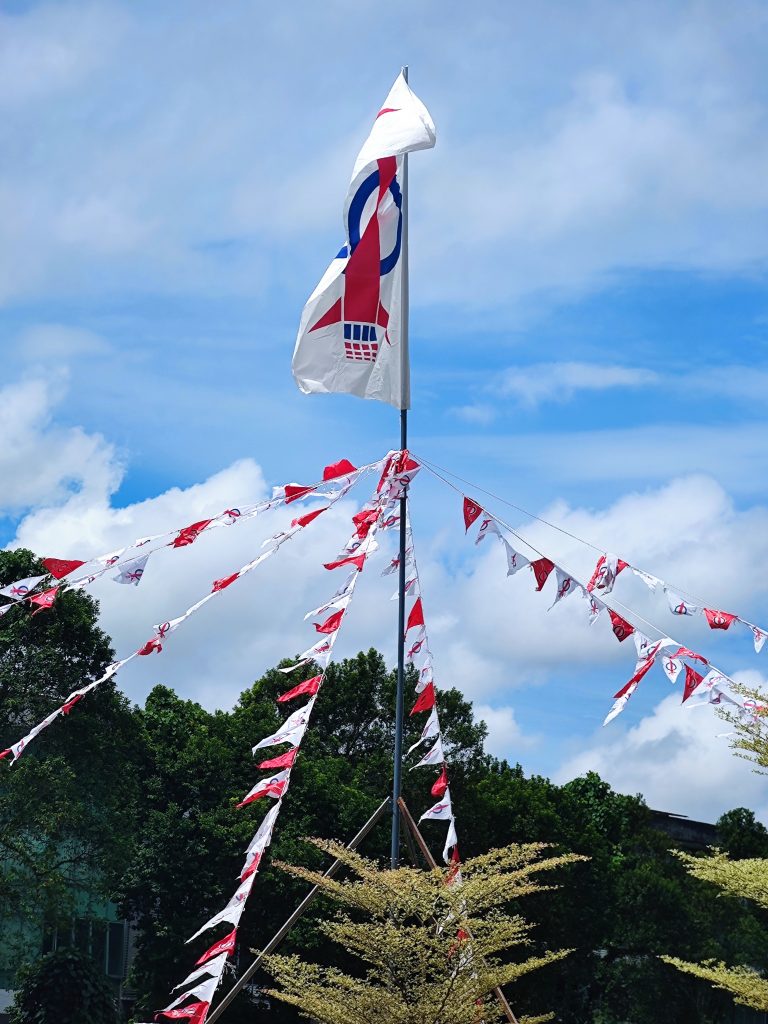
The Race to Conquer Them All
Construction worker *Tan volunteers to install these flags alongside his party comrades to ensure they are ahead in the flag war.
“I do it for the love of my party,” the 40-year-old says. “As we install the flags and banners along the street, my friends and I share our life stories, problems, laughter—everything under the sky.”
And when it comes to the all-important question of real estate, everywhere and anywhere is fair game, Tan explains. Having installed flags around Kuching, Sarawak for many elections before this, Tan says there isn’t much challenge when choosing locations to hoist them.
Sometimes, he tells me, he mischievously parks flags between the ones put up by competing parties.
“Everywhere, basically. As long as there is space.”
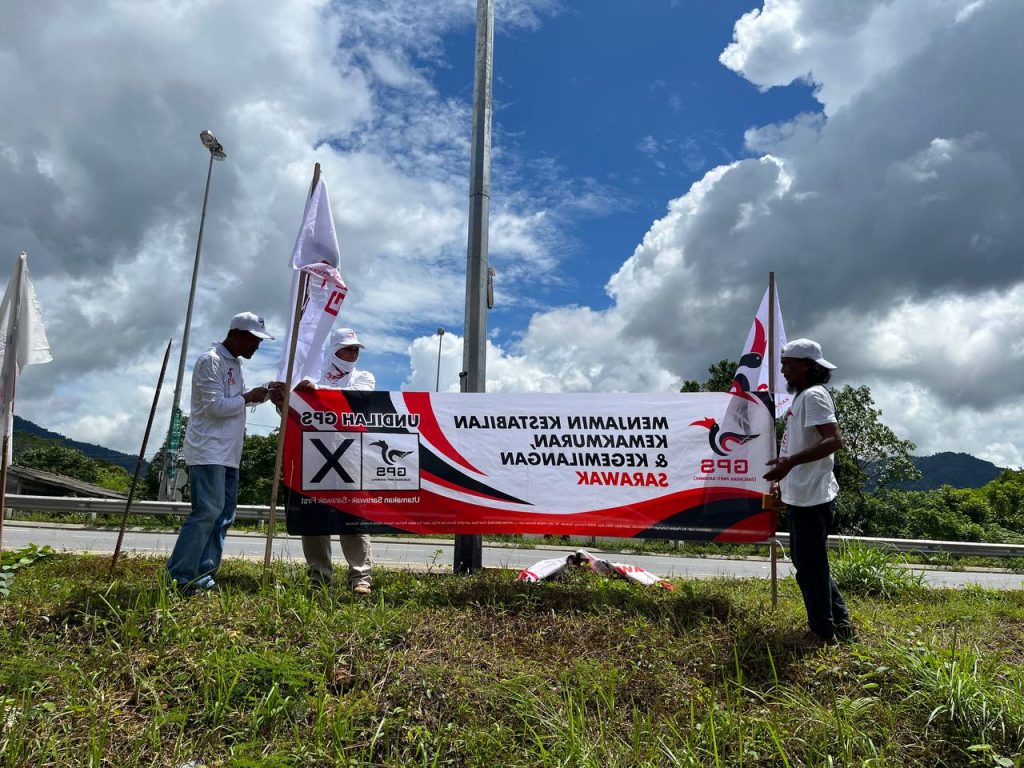
This installation is typically done after midnight on the nomination date. This would continue until polling day. Normally, they would spend roughly an hour installing flags and banners within two kilometres.
“More flags would be installed at places where the campaign rally is held,” said Tan, who drives his white Ford Ranger to each adventure.
Aside from the common flags on poles, Tan and his merry men would install another type of flag—a string of buntings tied across trees and poles.
“We usually do those after midnight, once the road is empty. This task is more of a hassle as we need to climb to a certain height because we cannot just leave the flags dangling on the road. It will be dangerous for car users.”
Once the election is over, they have to return to clear the flags and keep them safe in storage until the next election.
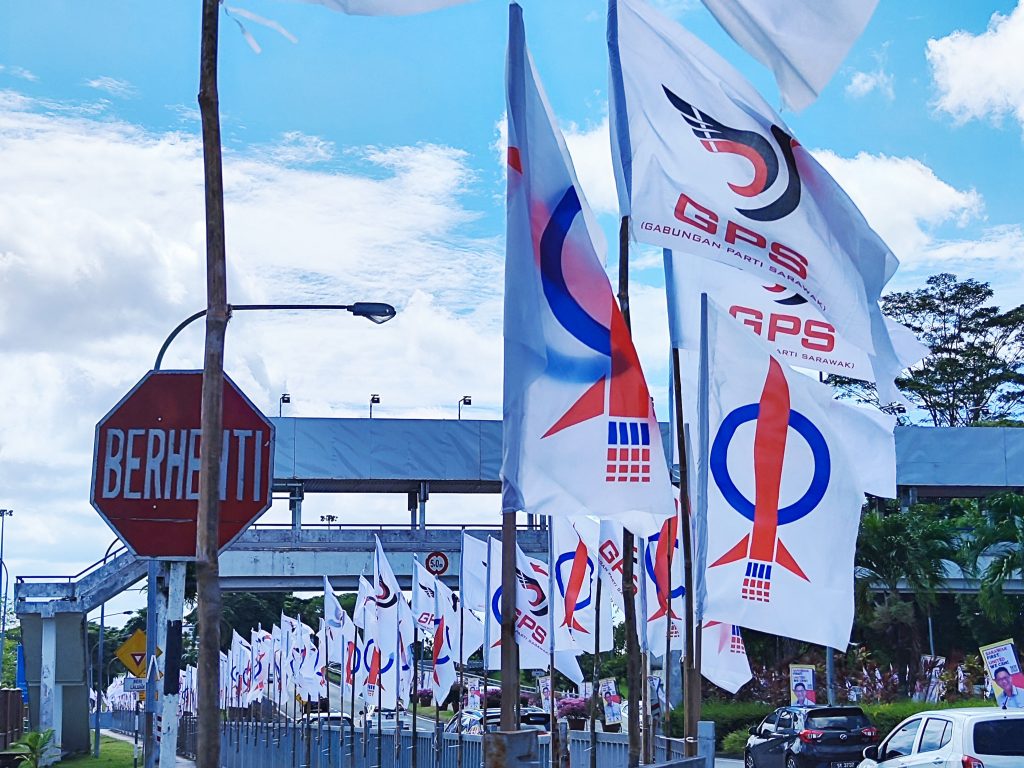
The Business of Printing Flags
During the election season, every printing company across the country goes the extra mile to keep up with orders.
Malaysian-based ProSales is one such company. Its Managing Director, Jamex Voon, tells me it is his fourth time handling orders for an election.
The first time his company was engaged to print flags was in 2016. He has since been hired for two state and two general elections. When I asked if Jamex chooses which political party he prints for, Jamex explained that, for him, it matters little who hires his company.
“I don’t see whether they are the government or the opposition party. To me, they are all my clients. Some would seek my service to print for the whole of Sarawak while others would only require collateral printed for distribution within Kuching.”
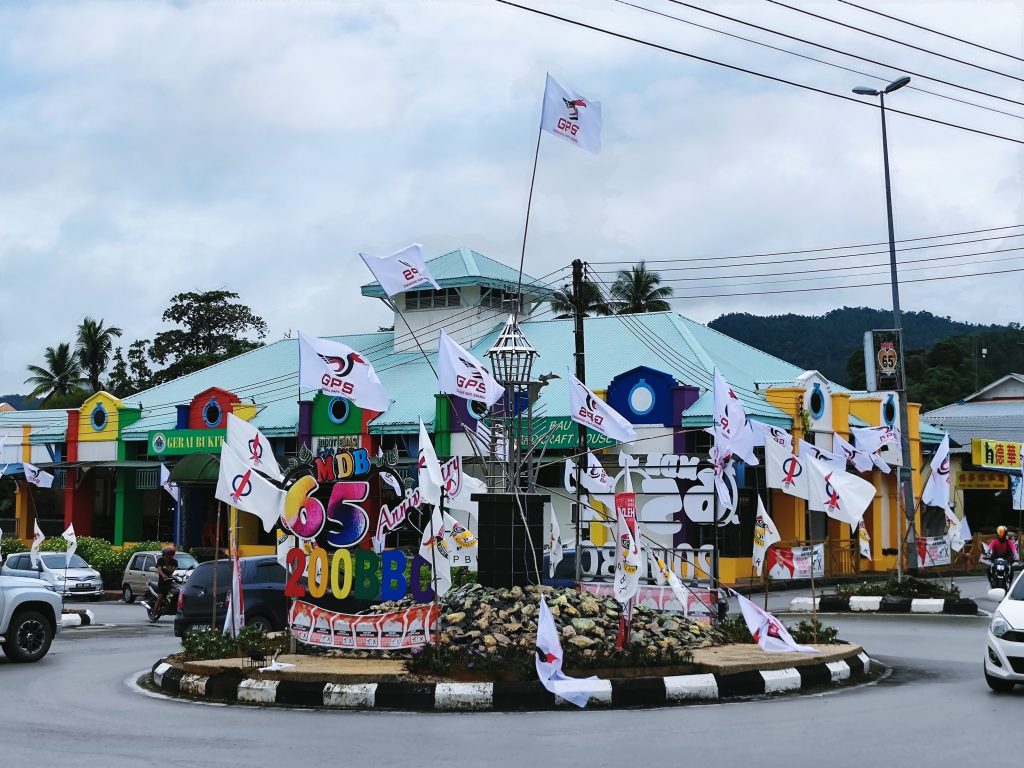
Nonetheless, the orders can be overwhelming during this period. Jamex reveals the need to print over 100,000 items—flags included—for each election. Unbeknownst to many, the printing process happens way before the two-week campaign period.
Typically, the orders start rolling in once Parliament dissolves. “Once we receive an order request, then that is when planning commences, followed by the payment of the deposit.”
This year, Prime Minister Ismail Sabri Yaakob dissolved the parliament on October 10 and announced nomination day 25 days later on November 5.
“In ProSales, we would start with general printing. All the flags with just the party logos are printed first. Then when the candidates are confirmed on nomination day, we gear up to print flags, banners, and billboards with their faces on.”
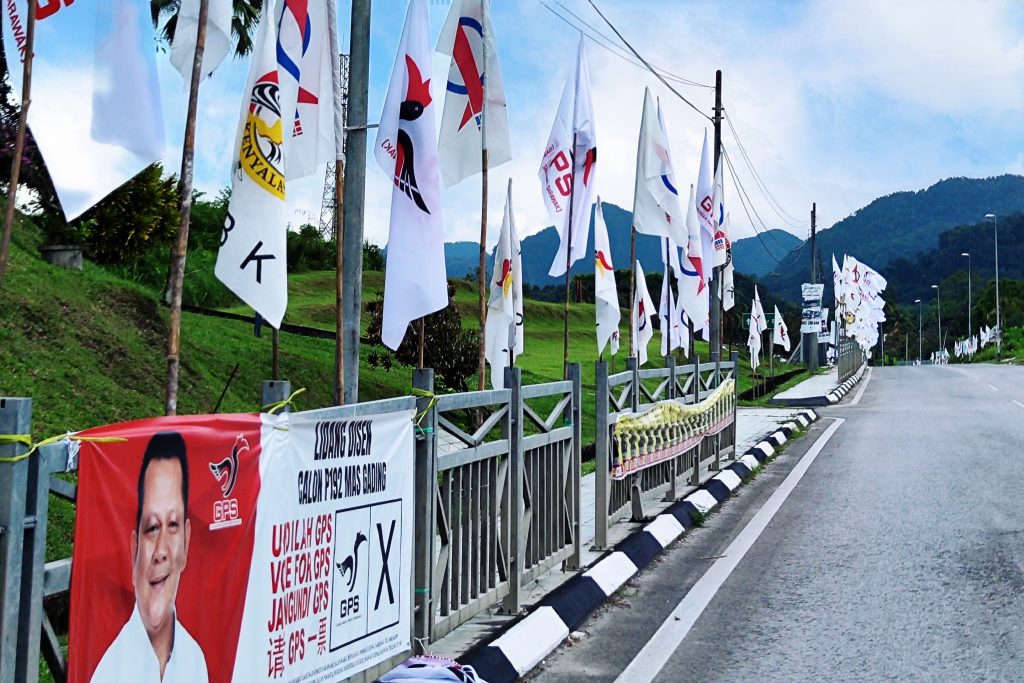
No Competition
Jamex also discloses that usually, the state election will see more orders than the parliamentary ones. “In last year’s state election, my production machine ran for 24 hours on many days until the orders were complete.”
With the temporary surge in demand, Jamex hires part-timers to help ease the workload. On a typical day outside of election season, an average of 10 employees work in the ProSales production team. Jamex had to triple his workforce, splitting the group into three shifts daily to meet the demands of a flag war.
In his early days, Jamex struggled under pressure due to a lack of experience handling a large order and the lack of an equally large team. These days, Jamex does just fine with the burgeoning demands.
“As long as we follow the Standard Operating Procedures I’ve laid out to handle big orders, everything should go smoothly.”
“Unless, of course, my machines break down. That’s when I will seek help from other printing companies. That is why it is important to build a good rapport with them to support each other during times like this.”
Elections typically sow discord and force citizens to take opposing sides. But in the printing industry, election season means kinship and rapport.
For ProSales, there’s no competition during the election season—only collaboration.
“We work with other printing companies on the projects together. Since the volume is overwhelming, it is impossible to be settled by just one company.”
If Jamex ever felt that he could not commit to an order, he would gladly recommend another company to pick up the project.
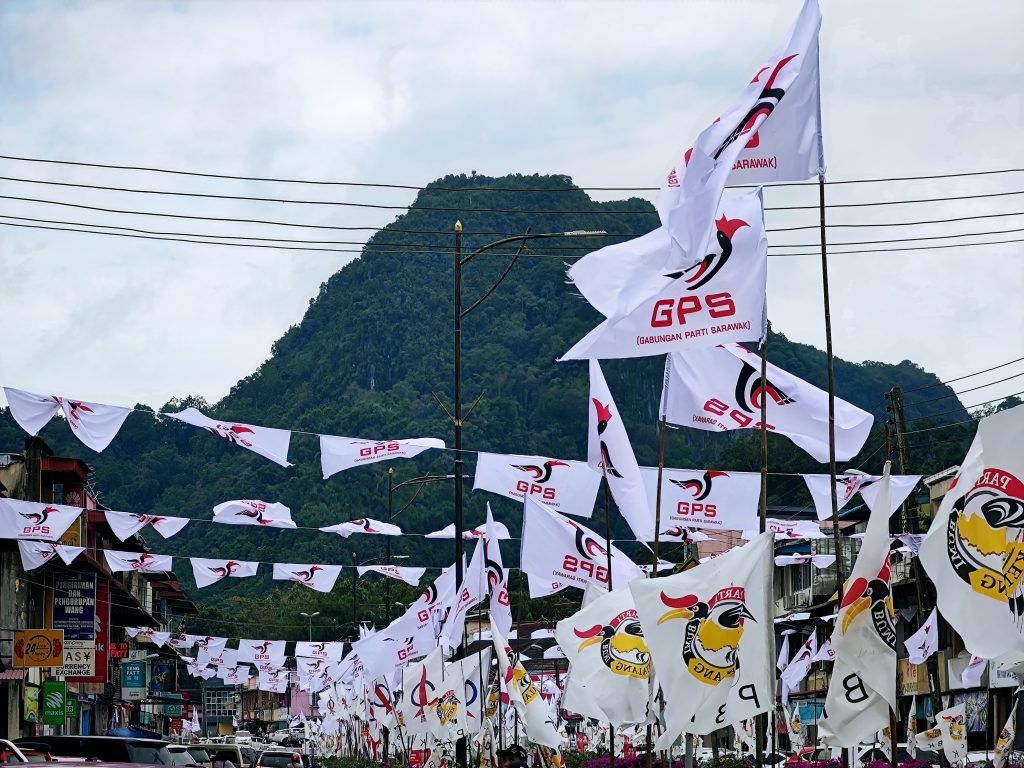
Is It Necessary in 2022?
By now, all Malaysians expect to see a slew of flags, banners and billboards of electoral candidates during every election. It is the very essence of the season.
Although physical advertising is fundamental, is it necessary to wage a ridiculous flag war across the country?
Political analyst James Chin, a professor of Asian studies at the University of Tasmania, opined that a flag war is necessary for representational purposes.
“If you don’t put up the flags, people will think your party is not well-known and does not have the resources; hence, the party would not appear as a serious player.”
The professor, in his late 40s, says that an electoral party installing rows of flags anywhere and everywhere is symbolic of a strong player in the game.
“Participating in the flag war gives a psychological boost to your supporters and front seaters. Despite digital advertising, flags are still important in giving confidence.”
It’s an opinion that Jamex concurs with. Over coffee, Jamex tells me that flags are still relevant because we tend to believe things we can physically see and touch.
He has a point. At campaign rallies, flags play an essential role as a visual identifier and as a show of confidence from the electoral parties to its members and supporters.
Much like flying military standards in war, election flags are often a source of pride, fellowship, and identity for party supporters. Perhaps the bigger the flag, the more capable the party looks.
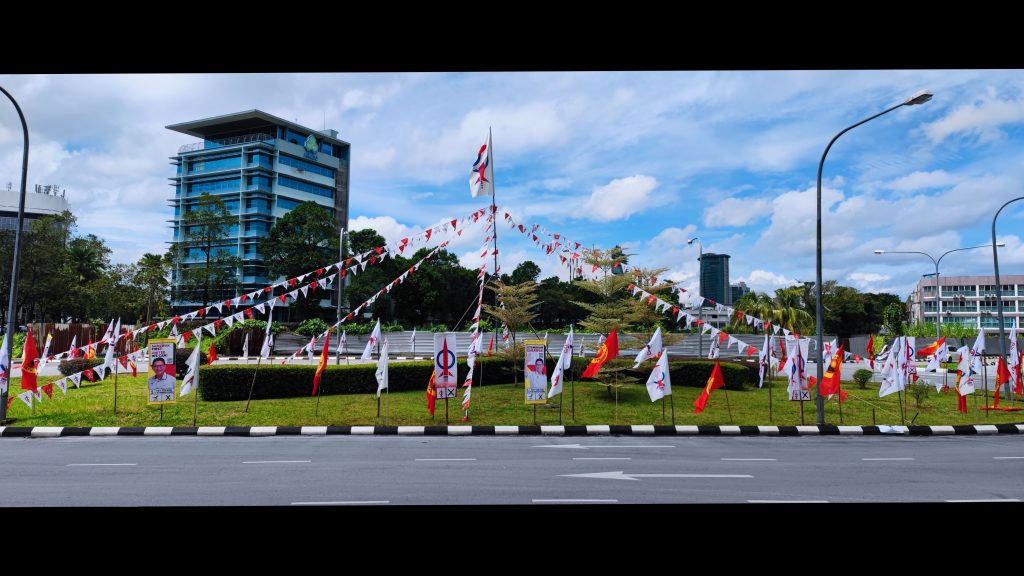
How Much For Impact?
The presence of flags further reinforces details of the election that voters may miss. Like pictures, the logos embellished on the flags speak a thousand words—more so when it is accompanied by the visual appearance of the candidates.
This is especially important as many of the candidates participating in this year’s election were from different parties previously or established a new party entirely.
And as voting day approaches, the number of flags put up by the roadside and in public spaces becomes more aggressive. Surely the cost of printing these flags leading up to D-day is astronomical. But, according to Jamex, it costs little.
“The cost to print a bulk of them is low. It is even lower than banners and buntings. That is why the flag war exists. Furthermore, these flags printed with the party’s logo can always be reused for the next election,” he shares.
When asked how much each flag costs to print, Jamex hesitated to disclose a figure. At the online shopping platform Shopee, a piece of 2ft X 4ft electoral party flag costs RM5 (S$1.50). Given a 40 percent markup, the cost price of each flag comes up to RM3.50 (S$1.05).
“It is not always about the money. It is the impact that speaks volumes,” James adds.
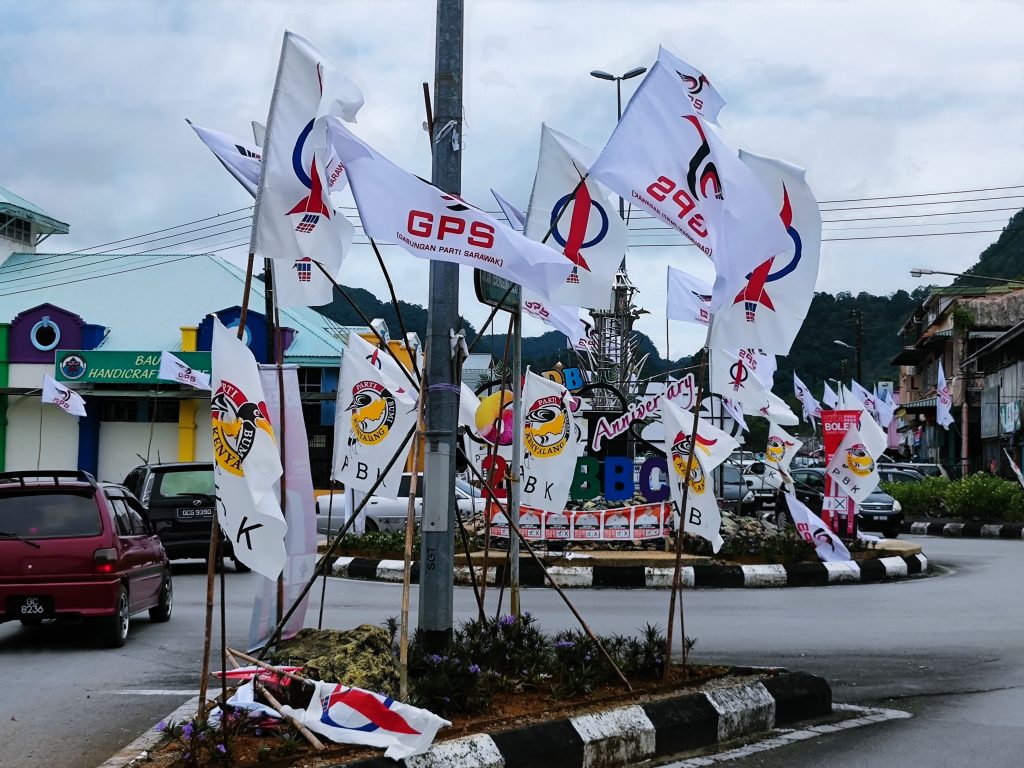
The Other Side of The Coin
While the flag war has its obvious advantages, TikTok user Tiviaa James, 29, seems to think the opposite.
In a recent video uploaded on social media, Tiviaa, a social media marketing officer, equates the flag war culture to an act of trashing the streets. “It is a 1970s promotional tactic that is outdated,” Tiviaa opines.
“You guys don’t think that the rakyat (citizens) are capable of doing factual research coupled with speaking to experts, listening to different points of views in forums? You don’t think that we are doing all those, right? Did you guys just think that we will essentially look at a party flag at the roadside and then decide to vote for you?”
And then, there’s also the unavoidable fact that these flags are often an eyesore when displayed in staggering numbers—especially when it ruins the external facade of a public landmark. Other times, it blocks the view of road users and endangers drivers.
To Tiviaa, the flag war is a waste of resources. “We already know that by doing all this, no one is concerned about the environment. We have already put up with so much rubbish from you guys; we don’t want to put up with literal rubbish.”
Regardless of whether you are for or against the tsunami of flags seemingly appearing out of nowhere every election period, its presence is inevitable. As inevitable as other things we Malaysians have had to endure in politics—corruption, money laundering, bribery, and, most recently, missing ships.
As I type these words, I’m sure even more flags are being put up. In Sarawak, white and red flags adorn the streets; in Sabah and West Malaysia, blues, greens, and whites dominate the landscape.
And as the polling date for the Malaysian 15th general election looms, some questions remain—which party flags would be the most prominent of them all this year? And, in the age of TikTok and information online, does the flag war really matter as much anymore?

